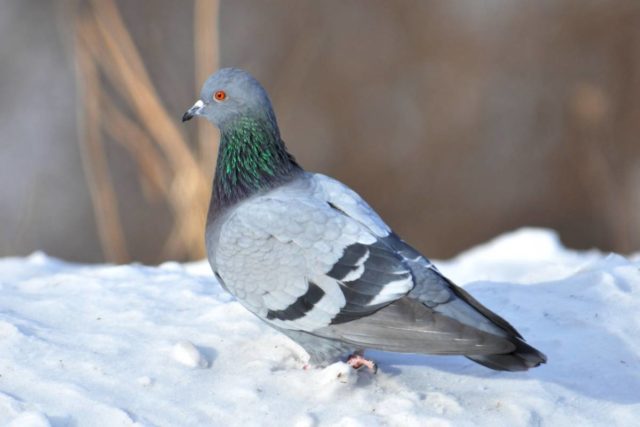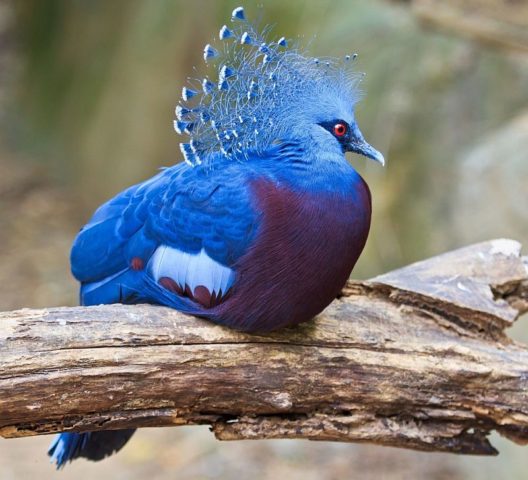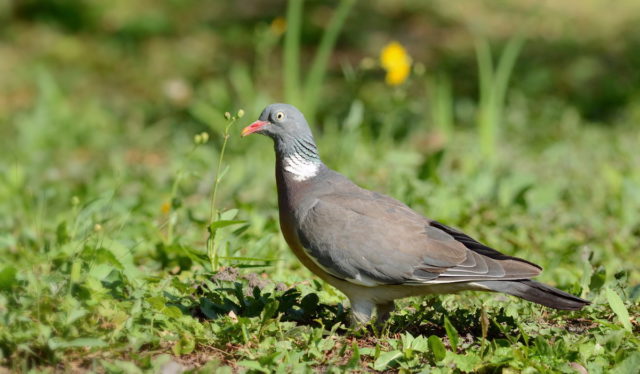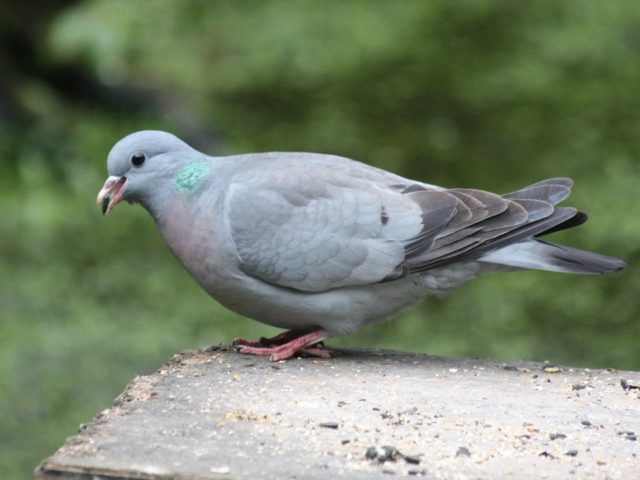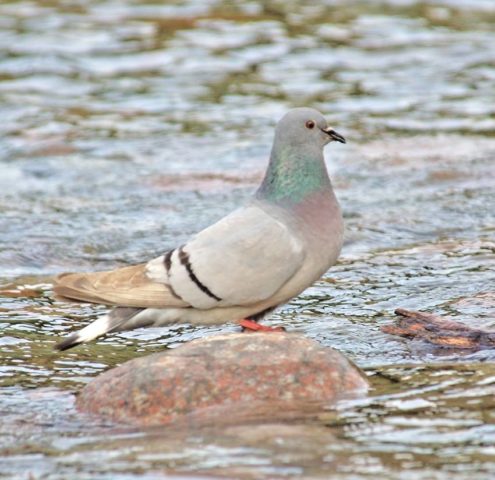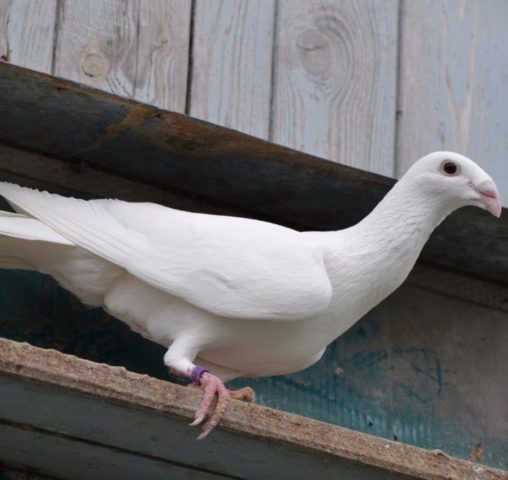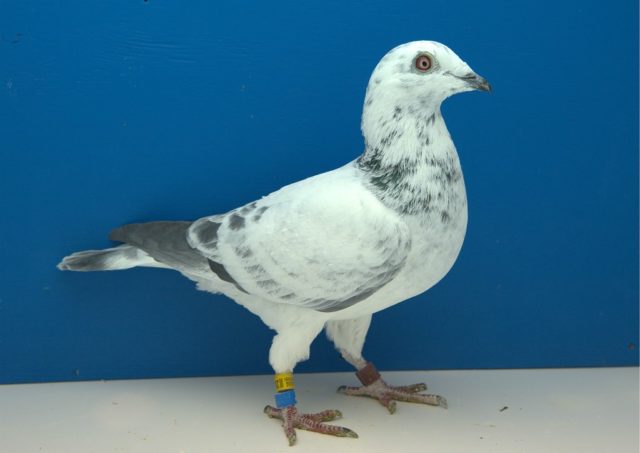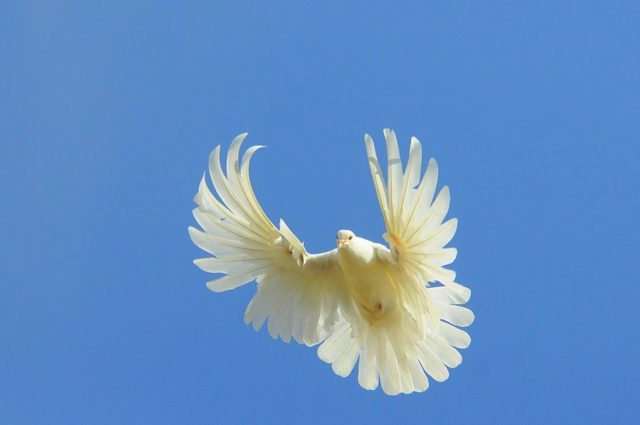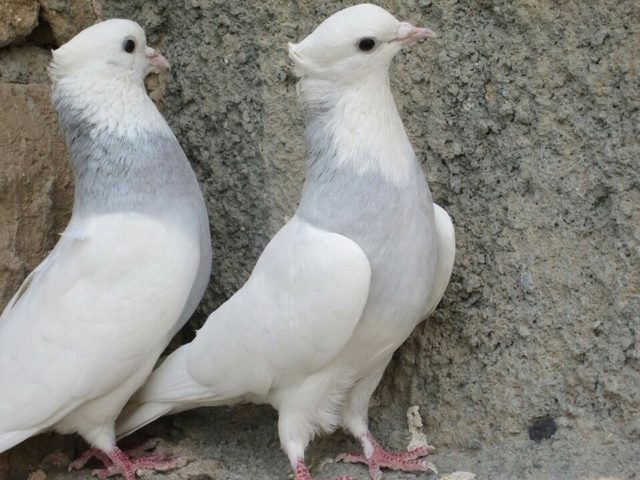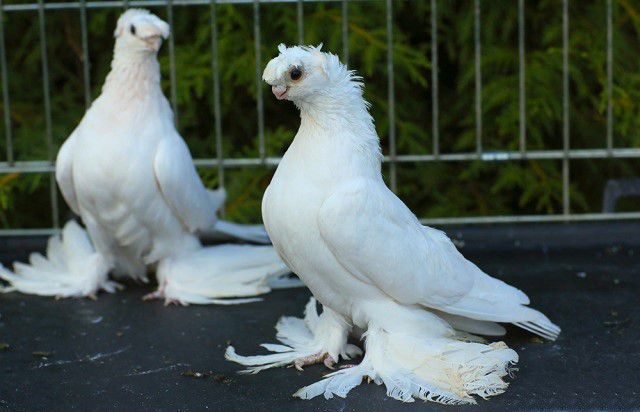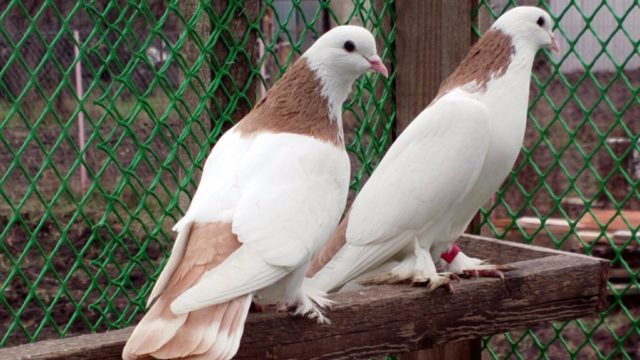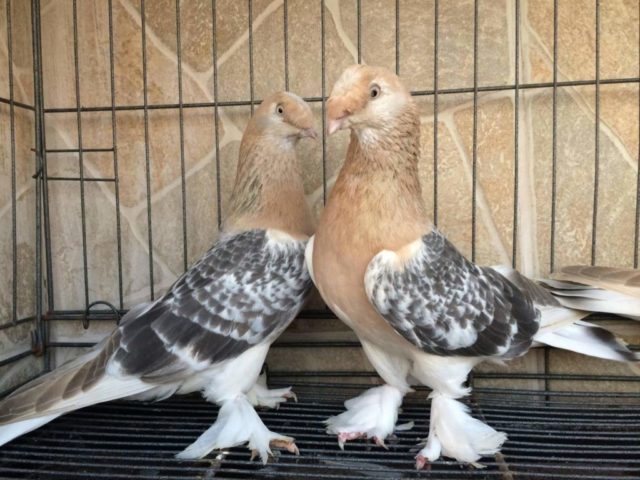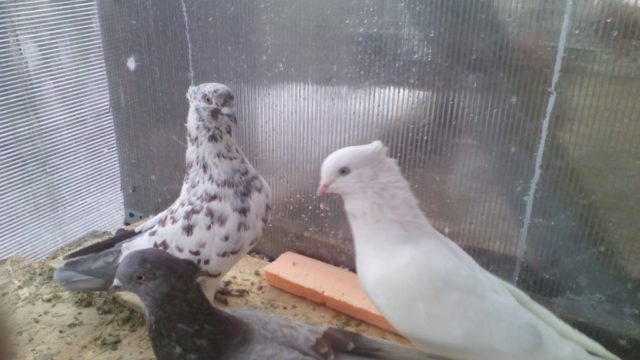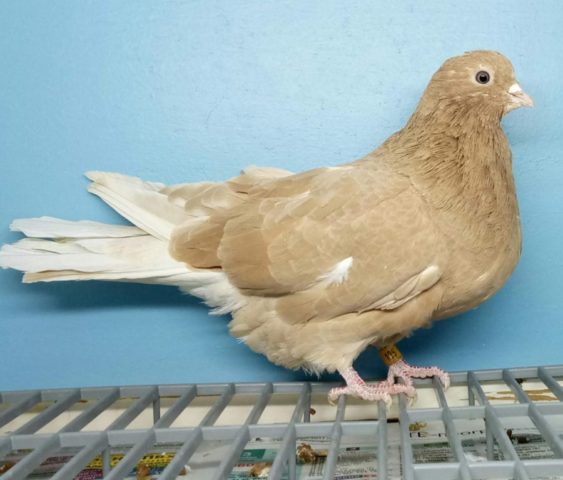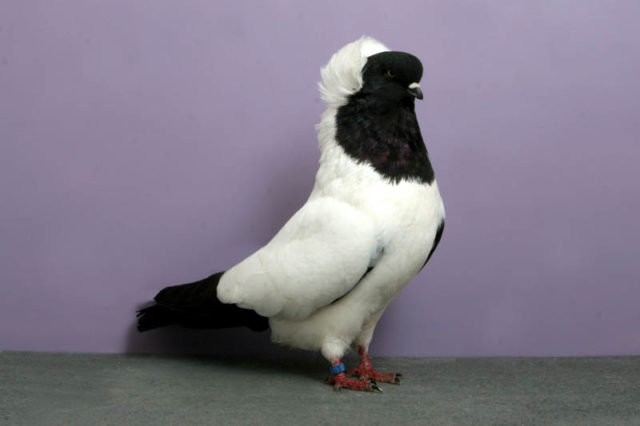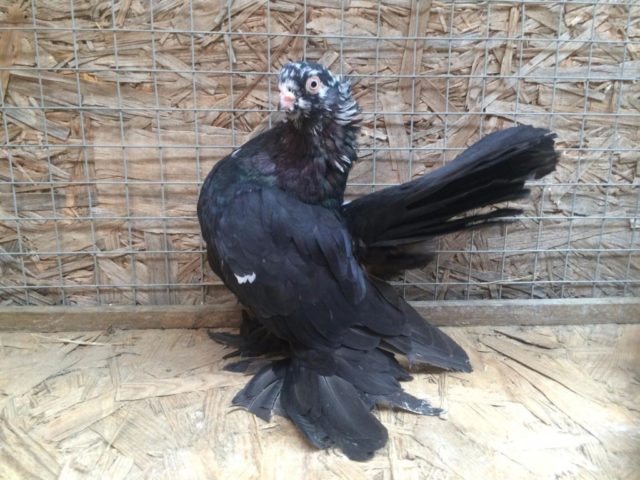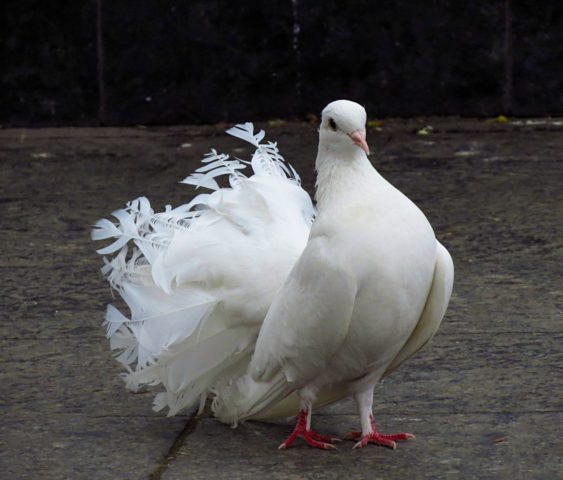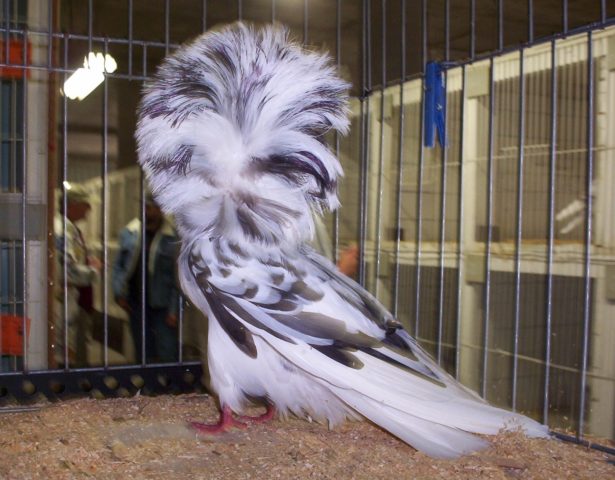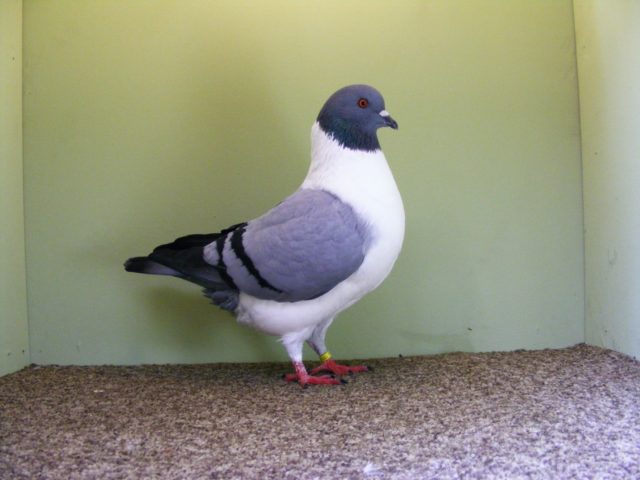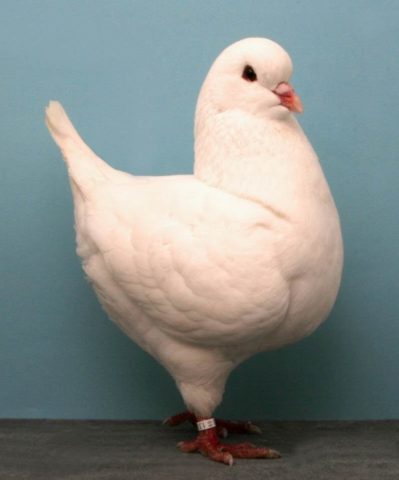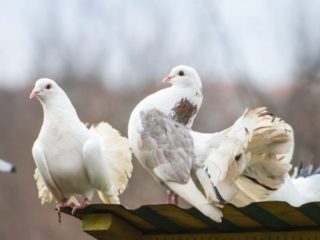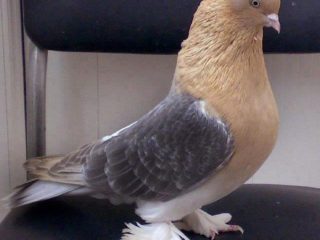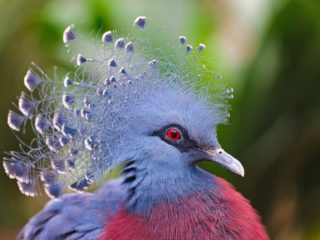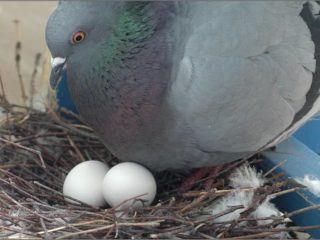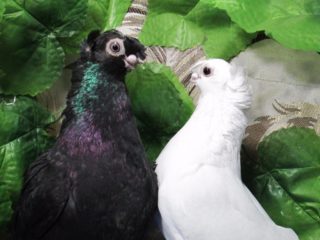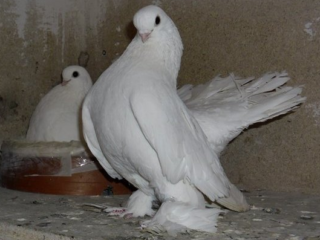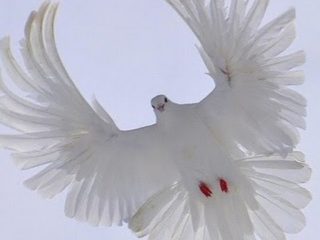Content
There are many different breeds of pigeons. The main choice that a novice pigeon breeder must make is what type of birds to keep. Pigeons are divided into wild and domestic. Wild purebred pigeons are more demanding in terms of maintenance. Therefore, novice breeders are recommended to breed domestic pigeons.
What does a dove look like?
There are about 800 varieties of pigeon breeds. Their appearance is often very different, but there are common characteristics. Description of the pigeon:
- small head, short neck;
- thin beak, slightly elongated, color depends on the color of the feathers;
- the eyes are large, the color may be different, the vision is sharp;
- the ears are covered with feathers, the hearing is excellent, birds are able to perceive ultrasound and infrasound;
- the body is neat, weighing up to 650 g, some breeds reach 900 g;
- legs are short with 4 toes;
- the plumage fits tightly to the body, the down component is well developed;
- the tail is rounded;
- wing length on average about 25 cm;
- the male is larger than the female;
- The color is varied, from light gray, beige to bright, rich, multi-colored like that of parrots.
The flight is rapid, up to 60 km/h. Racing pigeons can reach speeds of up to 140 km/h.
Types of pigeons
Today, about 35 species of pigeons belong to the pigeon family. They differ in shape, color, type of plumage, and size.
All varieties of domestic pigeons are descended from the common rock pigeon. The characteristics of this particular pigeon have been well studied and taken as a basis. When carrying out selection work, breeders sometimes obtain breeds that are completely different from each other. The following groups are known: sports (postal), flight, decorative, meat. Recently, meat and sport breeds have somewhat lost their former popularity.
Breeds of pigeons with photos and names can be seen below.
Wild pigeons
All types of wild pigeons are different and have features characteristic only of this species. They live in places remote from people - in forests, on river banks, and inhabit rocks. They live in groups. They find food on the ground and spend the rest of the time in trees or in flight. In addition to the external description of the breed of pigeons, behavior, ability to reproduce, and character differ. They are hardy, capable of flying up to 1000 km in one day. A mate is found for life. They hatch up to 2-3 eggs together with a partner. They feed on nuts, berries, and various fruits.
Rock dove
Another name is sisar. The bird is distributed throughout Europe and is found in Russia. Nests are built in rocks and stone buildings. They are very trusting and can be easily tamed. They have about 28 varieties. Swift in flight. The plumage is light gray. There are dark stripes on the outside of the tail. Weight up to 350 g.Sexual maturity occurs at six months, with 1-2 eggs in a clutch. Life expectancy in nature is about 5 years, at home about 30 years.
crowned pigeon
One of the most beautiful birds. It differs from other species in its large size (up to 70 cm), body weight up to 3 kg, small head, long beak. The main advantage of the crowned pigeon is its unusual crest, reminiscent of a fan. The feathers on the crest are blue, the tassels at the end are white.
They live in forests, shelterbelts, closer to farms, where there is more food. Very trusting of people. During the day they are busy searching for food and raising young birds. Caring towards the partner and chicks. They live in flocks, with pairs staying a little apart. They prefer cereals, grains, fruits, berries, seeds, and sometimes feed on insects and snails. They love fresh greens.
Wood Pigeon
It has several names: vityuten or forest wild pigeon. This species is larger than other members of the pigeon family. The body length of the bird is about 40 cm, weight up to 1 kg. It is the closest relative of city pigeons. The main color of the plumage is gray or gray, the chest is red, the neck is slightly metallic, and the craw is turquoise.
They live in coniferous and mixed forests of Scandinavia, the Baltic states, and Ukraine. They are found in Russia in the Novgorod, Gorky, and Leningrad regions. Depending on the habitat, it can be both a migratory and sedentary bird. Wood pigeons live in flocks. They prefer fruits, cereals, legumes, and berries as food; they rarely eat worms and caterpillars.
Klintukh
Inhabits the forests of Asia and Europe, quite common in Russia. Like the wood pigeon, it can lead a sedentary lifestyle or fly to warmer countries for the winter. The bird is small in size, up to 35 cm, weight about 370 g.The color of the plumage is smoky, the neck has a greenish tint. Treats people with caution. They can settle in a city park, but only if they find a suitable hollow in the trees. They feed on plant foods: seeds, berries, fruits, nuts. In spring they can eat insects.
rock pigeon
At first glance, it is no different from the city pigeon, but in fact these types of pigeons have different characteristics, as well as habits.
It was named after its main habitat. They inhabit gorges, rocks, and cliffs. The rock pigeon is smaller than the rock pigeon, the feathers in the tail are lighter, and two stripes are visible on the wings. They eat plant food, occasionally supplementing the diet with slugs, insects, and snails.
It is the ancestor of such breeds as pouters, peacocks, tumblers. Thanks to this species, the main groups of pigeons appeared: meat, decorative, flying, and postal.
Racing pigeons
They are representatives of the elite branch of pigeon breeding and are popular in many European countries. Previously they were called postal, as they delivered mail over long distances.
Breeders of racing pigeons care mainly about the aerodynamic properties of the bird, which consist in the correct proportions of body parts. A pigeon with good athletic ability should have a smoothly streamlined body with a powerful chest and a wide back. The tail is narrow, with abundant, close-fitting plumage.
Breeding racing pigeons is quite a popular hobby, but maintaining, caring for, and feeding requires a lot of expense and effort.To make a real athlete out of a pigeon, you need to choose the right chick, create a competent feeding diet, create all the necessary living conditions, and daily training is important.
Before purchasing a racing pigeon, you should study information about various nurseries, look at recommendations and reviews. The websites of elite nurseries usually provide all the necessary information, documents and photographs. Nurseries are located in many countries, but pigeons from Holland, the Czech Republic, Belgium, Germany, and Romania are more valued. There are also many clubs in Russia where they breed racing pigeons and organize competitions.
When starting to breed racing pigeons, you need to take care of the cleanliness of the dovecote. For a dovecote, it is better to use natural building materials, make an aviary for walking, the room should be warm, dry and light. Cleaning should be done daily, keeping drinking bowls and feeders clean.
Proper nutrition is important for sporting pigeons. It differs significantly from the diet of ornamental birds. For pigeons, grain mixtures and legumes should predominate: corn, peas, millet, hemp, lentils. You can add bread, boiled potatoes, rice, and herbs. We must not forget about vitamin supplements for racing breeds of pigeons.
Birds begin to be trained at two months of age. First of all, you need to accustom the pigeon to the owner and the dovecote. To do this, you should come to them at a certain time, in the same clothes. They must learn to respond to the owner and eat from his hands. Before you let them fly, you need to teach the pigeons to fly from the dovecote to the aviary and back.
These classes last about a week.After this, you can put the pigeons on the roof and let them get to know the area. The first flight lasts about 20 minutes, after which the flight time gradually increases. Next, they begin training in spatial orientation, starting with small distances and then increasing them.
Russian postal
The Russian breed of racing pigeons is considered one of the hardiest. They often take part in various international competitions. They fly long distances. A variety of Russian postal ones are white Ostankino ones. They have a sharp beak and a graceful head shape. The wings are powerful, located close to the body, the legs are long without feathers.
Belgian sports
In appearance it resembles a wild pigeon. The chest is powerful, muscular body, small rounded head. Eyes are dark in color. The tail is small, narrow, and the wings are shortened. The shades of plumage are varied. It is an expensive bird.
flying pigeons
The main quality of pigeons of this group is their ability to rise to maximum heights and stay in the sky for a long time. During breeding work to breed flying pigeons, birds with good muscular systems were selected.
Breeders of some breeds of flying pigeons believe that the ability to somersault in the air takes a lot of energy from the birds and does not allow them to rise higher and soar for as long as possible. Such birds are subject to culling.
Within flying breeds there are certain differences in the nature of flight:
- Bell tower – a pigeon, being at an altitude of more than 120 m, makes circular flights or simply flies;
- lark – the lifting height of such birds is 350 m;
- sparrow – lifting height up to 650 m;
- butterfly – flight at altitudes up to 840 m;
- flickering – rise to a height of up to 1500 m and disappear from view of observers.
Birds of these breeds must fly daily. Without training, flying birds quickly lose shape. In addition, they must fly in a flock; birds do not fly into the sky alone.
There are 3 types of flying breeds:
- simpley breeds, retained flight properties;
- stately (the main quality is decorativeness);
- fighting (special flight with somersaults).
Flying pigeons demonstrate their best properties in the area in which they were born.
Serpastiye
The credit for breeding this breed of flying pigeons belongs to Ukrainian breeders. Their main feature is their unusual wing shape. One of the joints has a convexity; when flying, pigeons spread their wings straight in front of them. The outer feathers are turned inward, slightly toward the center. As a result, they form two sickles. Pigeons were brought to Ukraine from Turkey. They have several varieties.
Crested pigeons rise quite high when flying. They float in the air for several hours. Flying out of the dovecote, the birds separate and fly around the territory on their own. Then they freeze in a vertical line - a bookcase.
This type of pigeon is medium in size, slender in build, and light in body. The color is assorted. Peculiarities:
- the wing is narrow, pointed;
- the tail is slightly longer than the wing;
- during flight, sickles are visible;
- flight quality is maintained in windy conditions.
Pigeons became the progenitors of the Tula and Ochakov breeds.
Nikolaevskie
They are a very valuable breed of flying pigeons among breeders. They first appeared in Nikolaev and quickly gained popularity on the Black Sea coast.They are considered descendants of rock pigeons and Turkish pigeons. They have an elongated small body, about 40 cm long. The color of the plumage is white, black, blue, red. The breed is divided into several varieties:
- whitetails (2-3 colored pens);
- color-sided (frontal part and sides of the same color).
The history of pigeons of the Nikolaev breed is interesting. Breeders did not pay much attention to the color of the bird and focused on improving its flight qualities. Now they are equated with decorative breeds and the birds have become more interesting in appearance, but their flight characteristics lag far behind.
Because of their special flight technique, they are called butterflies - in the air, pigeons constantly flap their wings, spreading a wide tail. They prefer to fly alone. During the flight they do not hang in the air.
Iranian
The breed belongs to the flight-fighting species of pigeons. Rising into the sky, they perform tricks, making characteristic clicks of their wings. For Iranians, who have long considered pigeon keeping a sacred activity, these pigeons are symbols of greatness.
The appearance is varied, but their features are a wide tail, legs without feathers, a dense body, good muscles, dense feathers. The head is small with a small crest. The most valuable is the combined color of the plumage. This breed of pigeon does not change color with age or during molting. Iranian pigeon breeders prefer birds without any marks on the plumage.
The flight of Iranian pigeons is slow and calm. A distinctive feature of flight is combat followed by exit into the pillar. The output is fixed - the pigeon hovers in the air for several seconds. Flight duration is from 3 to 10 hours.
Uzbek pigeons
All types of pigeons bred in Uzbekistan belong to flight-playing breeds.They are valued for their beauty and flight duration. Of all the breeds of domestic pigeons, they are considered the most freedom-loving. While hovering in the air, pigeons make very loud sounds - flapping their wings. In addition, they can somersault over their heads, rise higher into the sky and fall sharply down. Such fun in the air can last for hours.
The exact number of breeds of Uzbek pigeons is unknown. The most common breeds:
- short-billed (beak length no more than 8 mm);
- forelock (raised feathers on the back of the head);
- toothless (feathers on the head are smooth);
- nasodentate (presence of a forelock on the beak and cere);
- two-toothed (one forelock is located on the back of the head, the second above the beak)
In addition to the listed species, Uzbek shaggy-legged pigeons are valued all over the world. They are characterized by the presence of rich feathering on their legs.
Baku
This variety of flying pigeons is popular among breeders in Russia and the CIS countries. They have won fans due to their very high flight and beautiful flight, as well as their varied plumage colors. They have the perfect combination of flight properties and impeccable appearance.
The homeland of Baku pigeons is the city of Baku, where breeders paid attention, first of all, to flight qualities. Previously, in the middle of the 20th century, they were not distinguished by their beauty. Subsequently, after extensive selection work, they became the owners of excellent flight characteristics and beautiful appearance.
Among the Baku breed there are shaggy-legged and bare-legged ones. Chubby pigeons and pigeons with a variety of plumage colors.
“Baku residents” fly individually in scattered places, demonstrating their skills to amateurs.
Takla
The Turkish breed of flying game pigeons, Takla, has gained international recognition. In Turkish, takla means somersault. During the somersault, the pigeons make a click and enter the vertical.
It is known about the origin of the breed that it came to Turkey in the 11th century with nomads from Central Asia. We became interested in pigeons because of the rich feathering of their legs and forelocks on their heads.
Today, most Russian fighting breeds are descendants of Turkish taklas. The bird is very easy to train, intelligent, and has topographic memory.
Features of takla:
- able to fly all day;
- when flying, they enter the pillar several times in a row;
- flight height in the column is about 20 m;
- the battle lasts from 2 to 5 hours;
- Birds of discreet colors have the best flight qualities.
There are more than two dozen varieties of takla: Syrian diving, Iranian fighting, Iraqi fighting group, Armenian.
Andijan
One of the most ancient breeds of Uzbek pigeons. It is known that they were brought to Andijan in 1890 from Iran. Over the years, the breed improved its qualities, including flying. They are an artificially bred breed of pigeons. Pigeon breeders have achieved the following indicators:
- body weight up to 400 g;
- body length 40 cm;
- the chest is powerful, girth 28 cm;
- head of medium size, eyes large;
- legs are straight, with slight feathering;
- tail up to 18 cm.
They are valued by breeders for their calm disposition and excellent flying qualities. Very hardy. Flight duration is up to 8 hours. The peculiarity of the flight is that when they enter the pillar, they freeze in the air for several minutes. Rising into the sky, they make circular movements. They fly in a flock. They have a strong attachment to home and owner.
Izhevsk
Bred at the beginning of the twentieth century in Udmurtia.A rather large bird, but despite this, it is capable of flying to such a height that it is practically invisible from the ground. The flight duration is several hours. It is not recommended to release them in bad weather and during molting, since the loss of the flight feather will not give them the opportunity to take off normally. Walks of the Izhevsk breed of pigeons need to be controlled. If the flock flies for 4-5 hours, then they can be released daily. After long flights (12-15 hours), it is better to give them a chance to rest the next day.
Izhevsk pigeons are characterized by well-developed muscles, a powerful body, dense plumage, a wide tail and long wings.
Monks
The monk pigeon breed was loved by German breeders in the 17th century for its unusual appearance and noble manners. They were given their name for their interesting color, reminiscent of a monastic robe. Breeds of German monk pigeons are divided into German cross and Moscow.
Very friendly breed. When a stranger appears, they gladly invite him into their flock. Very caring parents - they can hatch their own and other people's chicks. Breeders take advantage of this.
They fly low, but quite maneuverable. Not adapted for long flights.
Decorative
The most popular bird among domestic pigeons. This is a fairly large group of pigeons with a varied appearance.
There are no specific standards for decorative breeds. Many varieties are similar to each other. Breeders are attracted by their unpretentiousness to living conditions.
Occurred by crossing different breeds of domestic pigeons.
Stately
The breed of stately pigeons became known in the 17th-18th centuries. They first appeared on the territory of the Kuban and the banks of the Don. Further, the habitat expanded significantly.The breed received international recognition in Budapest in 1975. Distinctive features of stately pigeons:
- the tips of the wings are lowered to the ground;
- raised tail;
- breast raised;
- varied color;
- decorative feathers on the legs and back of the head.
They have many varieties.
Peacocks
They are one of the most ancient breeds of pigeons in the world. They were recognized for their grace, graceful movements and high fertility. At one time they decorated the palaces of rajahs, and in the 16th century they appeared in England and spread throughout Europe. They have a peaceful disposition and do not like to fly. They are bred solely for aesthetic purposes.
Jacobin
In Europe, this pigeon is called the wig pigeon. It got its name thanks to a certain wig - vertically growing feathers. This “hairstyle” blocks the view and because of this the flight characteristics of the pigeon suffer greatly. The bird's body is proportional, long legs, thin tail. The color of the plumage is varied.
They are popular at exhibitions because they look very impressive. They are somewhat pampered by nature, but nevertheless they are caring parents.
Meat pigeons
Meat breeds of pigeons are raised and bred for subsequent consumption. They differ from other varieties in their large build, their average weight is about 650 g. More than 50 breeds belong to this group of pigeons. Many breeds are bred in the USA, France, and Italy on a large scale for sale. Each breed of meat pigeons is varied in appearance, weight, color and fertility.
Strasser
The weight of the bird reaches 1 kg. The body is large, with a protruding chest. They fly very poorly. They can be varied in plumage color. They have a tough temperament and often get into fights. They have high fertility.When bred within the breed, they are able to maintain high productivity rates.
Kings
A breed of pigeons was created after selection work by US breeders. Kings differ from other meat breeds in that they are often used both as birds for fattening for meat and as an exhibition species.
The breed is unusually prolific. They are caring parents. During the season, the female makes 6-8 clutches. The weight of a pigeon reaches 850 g. In appearance they resemble galliform birds.
Domestic pigeons are shown in the video below.
Conclusion
Pigeon breeds are interesting and varied. They started breeding them a long time ago. Pigeons were always close to man, trusted him and served him. And today pigeon breeding is enjoyed all over the world. This popularity is due to the fact that maintaining and caring for them does not cause any particular difficulties.
